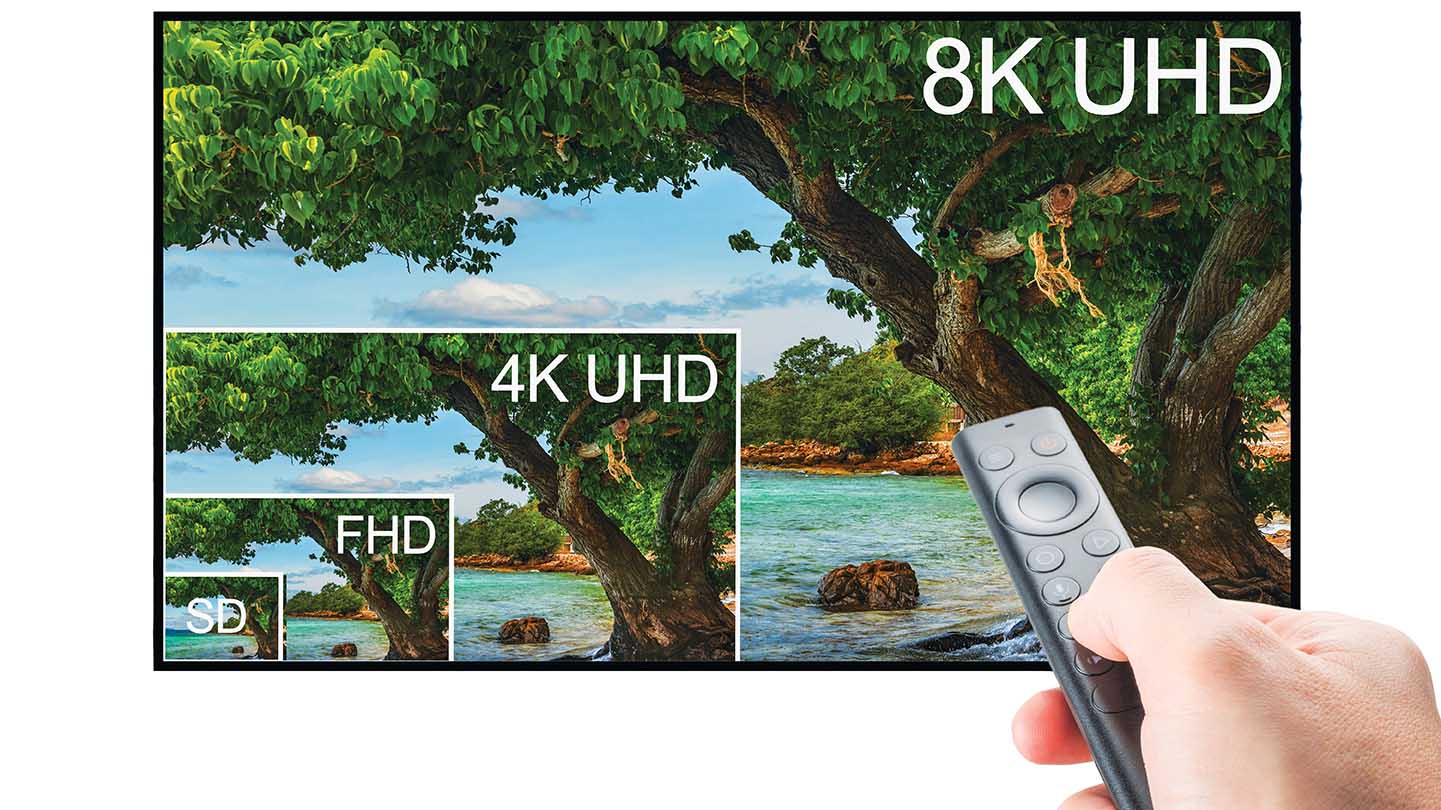The astounding resolution of an 8K monitor is 7,680x4,320 pixels. That's four times as much resolution delivered by a 4K monitor and 16 times the resolution of a 1080p HD display. But while 8K TVs are now available at Best Buy, Walmart, and other major retailers, the technology is having a hard time grabbing the public’s attention like HDTV did.
The reasons?

“8K may be suffering from slow sales because the consumer market has never been fully saturated with 4K—and then 8K came along too quickly following it,” offered Renard T. Jenkins, president of the Society of Motion Picture and Television Engineers (SMPTE). “Another thing to keep in mind is that the typical human optical system [vision] cannot easily decipher a significant difference between 4K and 8K. That makes it hard to justify increased costs for a broadcaster, prosumer, or consumer."
That said, Marc Finer, founder and director of Communication Research, said 8K's initial introduction more than five years ago wasn't really based on content. Instead, it was driven by "advancements in panel fabrication and an interest in the fabricators and manufacturers of displays to elevate the market to the next level,” he said. “In recent times, there's been a newfound discovery of the impact of immersive viewing on the end user in almost every application imaginable.”
It is this level of ultra-accurate immersive viewing that makes 8K so appealing to Pro AV designers and installers today. “Our industry is driven by innovation and enhancing the user experience, along with delivering the emotional impact associated with the highest quality, most lifelike audio and video content,” explained Mike Fidler, executive director of the 8K Association. “The significant enhancement in resolution and pixel density offered by 8K provides the creative community with the tools they need to achieve greater realism and more emotionally engaging storytelling, particularly in conjunction with the latest advances in TV technology like mini and microLED, QLED, and OLED displays.”
Assorted Applications

The fact that 8K TVs are still rarities at home doesn’t detract from their usefulness in business, education, and government—all markets that consume Pro AV services. Case in point: “8K is essential where precision and image clarity is needed, such as high-end gaming and professional video editing,” said Joe Drury, Pro BRAVIA business manager, Sony. “It is also important for certain industries such as healthcare, engineering, and design where accuracy of visualization is pivotal.”
[Strategies and Solutions for Corporate Campus Displays]
In the broadcast and content production industries, Jenkins said 8K can easily make a case for archival use and better origin file from production. But that’s just the beginning.
“The 8K ecosystem has advanced far beyond its initial introduction and today provides full end-to-end technology solutions including image capturing, pre and post production, editing, encoding and decoding, distribution, and displays,” said Fidler. “8K also supports other advanced new technologies, such as the latest AI upscaling processors that provide the ability to upgrade from HD and 4K to near 8K performance. Additionally, 8K is gaining a strong foothold in the smartphone, camera, and gaming categories, as well commercial applications like security and medicine.”
“It takes time to build the necessary infrastructure, develop compelling content, and improve the ability to deliver this content using more efficient algorithms.”
Mike Fidler, 8K Association
Speaking of broadcasting, the 8K Association recently assisted Intel at an event in Los Angeles demonstrating live 8K streaming of the 2024 Olympics from Paris. “The sheer immersiveness and sense of ‘being there’ impressed all those that attended," Fidler recalled, "and underscores the opportunity for companies to deliver this exceptional experience to consumers. This is why NHK in Japan is already delivering two 8K channels—and 8K content is also being streamed via YouTube.”
[CEDIA 2024: Resi Integrators Are Going Commercial]
The takeaway: 8K is already proving its worth in a wide range of Pro AV applications. As such, the enhanced resolution offered by 8K, combined with the degree of future-proofing that installing 8K monitors provides to Pro AV customers, begs a very simple question for Pro AV personnel: Why would you install 4K today when 8K is available now?
Clearing Hurdles
The fact that there is a solid business case for 8K in Pro AV doesn’t mean that the transition to this new standard will be free of hurdles. In fact, there are a number that will have to be cleared.
“There are currently limitations with 8K going mainstream,” said Drury. “In the professional environment, the content has to either be cast or provided by storage, which this content would strain. The ideal speed for 8K is 100 Mbps per device, and a single minute of 8K footage can require approximately 20 GB of storage.”

Then there’s the issue of streaming. Experts say a minimum of 50 Mbps is needed to transport flawless 8K video to end users, versus 25 Mbps for 4K and 5 Mbps for 1080p. The good news? According to the 8K Association, the use of the H.266 codec—also known as Versatile Video Coding or VVC—can reduce the capacity needed to stream 8K to 40 Mbps, which is why the association is backing this standard.
“The final standard for VVC was completed in July 2020,” Fidler noted. “Mediatek, an 8K Association board member, has introduced advanced SoCs that incorporate VVC. Now, there are still issues to resolve related to IP and licensing before we can see widespread hardware adoption. However, we anticipate future support from all of the key players in the TV, mobile, and computer space, given the significant advantages that VVC provides in compression efficiency and bit rate improvement.”
As a result, the 8K Association believes that the transition to 8K will take more time than the switch to 4K. “Although there is a growth in content being shot in 8K, there is slower growth due to the size of media, additional costs to create and store content, and challenges to current infrastructure for playback,” Fidler explained. “It takes time to build the necessary infrastructure, develop compelling content, and improve the ability to deliver this content using more efficient algorithms. Time also enables TV makers to improve their production capabilities with greater scale while continuing to drive other advances.”
Fidler’s concerns are echoed by SMPTE’s Jenkins. “To be honest, it always comes down to distribution efficiency, compression, file size, and simplicity in the workflow,” he said. “If any of those factors lag behind, adoption will lag as well. This is why the industry, including SMPTE, have been and continue to work to improve these factors and foster interoperability, which we feel will lead to adoption.”
According to many experts, 8K is the Next Big Thing in video picture resolution. Although its improved clarity may not stand out in home settings when 4K is already in use, 8K offers a truer "step up" for video clarity in Pro AV installations, immersive or not. This is why 8K is too big a trend for Pro AV to ignore—enhanced picture quality means greater creative possibilities for Pro AV creators, integrators, and end users.

